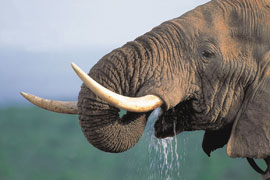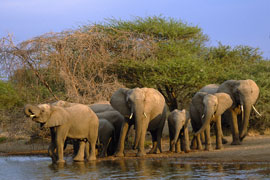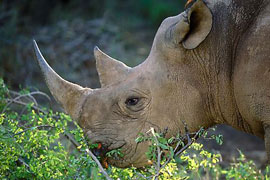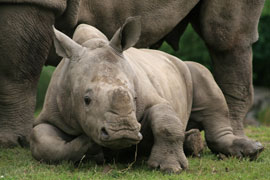South Africa Information
South African Wildlife
Our South African wildlife gallery represents a small sample of the hundreds of species of wildlife found in South Africa. (The term 'wildlife' refers to mammals, birds, fish and reptiles that can be found in the wild). There are 299 mammal species in South Africa, of which 2 are critically endangered, 11 are endangered, 15 are vulnerable, and 13 are near-threatened (conservation status as assessed by the IUCN).
To learn more about the individual wildlife species that can be enjoyed whilst visiting South Africa and enjoy the wildlife photos in the galleries please use the drop down list in the menu on the right or browse through the information provided below.
To learn more about the individual wildlife species that can be enjoyed whilst visiting South Africa and enjoy the wildlife photos in the galleries please use the drop down list in the menu on the right or browse through the information provided below.
South Africa Wildlife
The Elephant {Loxodonta Africana}

The African Elephant
The trunk of the African elephant has two finger-like structures at its tip. The tusks, another remarkable feature, are greatly elongated incisors (elephants have no canine teeth). Tusks grow for most of an elephant's lifetime and are an indicator of age. They are "right or left tusked" using the favoured tusk as a tool, shortening it from constant wear.
Quick Facts
Size: Up to 11 feet; Weight: 3½ - 6½ tons
Diet: Herbivorous
Diet Description: Elephant graze and browse and eat up to 600 pounds of food a day. They can be extremely destructive in their feeding habits by pushing over trees, pulling them up by their roots or breaking off branches.
Distribution: They are widely distributed throughout central, western and eastern Africa, south of the Sahara, with the forest elephant inhabiting the rainforests of the Congo basin. There are isolated populations in the southern African sub-region.
Habitat: Dense forests to open plains - Clean drinking water and a plentiful supply of food are an elephant's only habitat requirements. They graze and browse and eat up to 600 pounds of food a day. They can be extremely destructive in their feeding habits by pushing over trees, pulling them up by their roots or breaking off branches.

African Elephant
The female family groups are often visited by mature males checking for females in estrus. Several interrelated family groups may inhabit an area and know each other well. When they meet at watering holes and feeding places, they greet each other affectionately.
Reproduction: Single young born any time of the year. Gestation 22 months.
Life span: 60 to 70 years
Interesting Facts: The elephant is distinguished by its high level of intelligence, interesting behavior, methods of communication and complex social structure. Elephants seem to be fascinated with the tusks and bones of dead elephants, fondling and examining them. The myth that they carry them to secret "elephant burial grounds," however, has no factual base.
South Africa Wildlife
The Rhinoceros

The Rhinoceros
The white or square-lipped rhino is one of two rhino species in Africa. It in turn occurs as two subspecies, the southern and the northern. The southern dwindled almost to extinction in the early 20th century, but was protected on farms and reserves, enabling it to increase enough to be reintroduced. The northern white rhino has recovered in Democratic Republic of Congo from about 15 in 1984 to about 30 in the late 1990s. This population has been threatened by political conflict and instability.
Quick Facts
Name: Black Rhinoceros - Diceros bicornis
Name: White Rhinoceros - Ceratotherium simum
The White Rhino: The white rhino's name derives from the Dutch "weit," meaning wide, a reference to its wide, square muzzle adapted for grazing. The white rhino, which is actually grey, has a pronounced hump on the neck and a long face.
The Black Rhino: The black, or hooked-lipped rhino, along with all other rhino species, is an odd-toed ungulate (three toes on each foot). It has a thick, hairless, grey hide. Both the black and white rhino have two horns, the longer of which sits at the front of the nose.
Size: The rhinoceros stands about 60 inches at the shoulder.
Weight: Black Rhino: 1 to 1½ tons. White Rhino: over 2 tons.
Habitat: Grassland and open savannahs. Black rhinos have various habitats, but mainly areas with dense, woody vegetation. White rhinos live in savannahs with water holes, mud wallows and shade trees.
Diet: Vegetarian. Black Rhino - browser. White Rhino - grazer.
Diet Description: The black rhino is a browser, with a triangular-shaped upper lip ending in a mobile grasping point. It eats a large variety of vegetation, including leaves, buds and shoots of plants, bushes and trees. The white rhino is a grazer feeding on grasses.

The Rhinoceros
They have an extended "vocabulary" of growls, grunts, squeaks, snorts and bellows. When attacking, the rhino lowers its head, snorts, breaks into a gallop reaching speeds of 30 miles an hour, and gores or strikes powerful blows with its horns. Still, for all its bulk, the rhino is very agile and can quickly turn in a small space.
The rhino has a symbiotic relationship with oxpeckers, also called tick birds. In Swahili the tick bird is named "askari wa kifaru," meaning "the rhino's guard." The bird eats ticks it finds on the rhino and noisily warns of danger. Although the birds also eat blood from sores on the rhino's skin and thus obstruct healing, they are still tolerated
Lifespan: 35 to 40 years.
Reproduction: Young are born after a gestation period of 16 months.
Predators: Humans. Man is the cause of the demise of the rhino. In the wild, the adult black or white rhino has no true natural predators and, despite its size and antagonistic reputation, it is extremely easy for man to kill. A creature of habit that lives in a well-defined home range, it usually goes to water holes daily, where it is easily ambushed. The dramatic decline in rhino is unfortunate in an era of increasing conservation but efforts are underway to save the rhino from extinction.

No comments:
Post a Comment